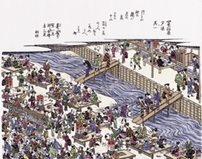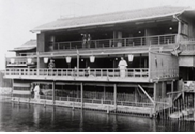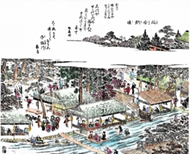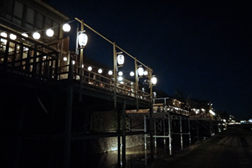Gravity(Attraction) of Kyoto 10 Riverside platform (Kawa yuka) Kamogawa riverside platform, Kibune riverside platform (Kawa doko)
Yoshie Doi
 Kamo River: Enjoying the cool evening air in the Edo period |
 Kamo River in the Taisho period Minokichi |
 Enjoying the cool evening air in the Edo period Kawai Summer Breeze Tadasu no Mori |
 Today’s Summer riverside platform (Enjoying the cool breeze :Kawazoko) |
”How cool is the river that flows steadily from north to south through the capital” – Yosa Buson
Buson recites that in the hot city of Kyoto, the Kamo River flowing north to south is extremely cool.
The Kamo River that runs through Kyoto City is also a river where we can fish for sweetfish, and it has long been a popular open space, with the custom of cooling off in the Kamo River during the hot summer months said to have existed since the Heian period. The custom of lining up stools in the river to cool off in the evenings dates back to the time of Toyotomi Hideyoshi. It is said to have begun when a wealthy merchant placed stools in the shallows of Gojogawara to entertain guests from afar during the hot Kyoto summers.
The first records of Noryo-yuka as an annual event in Heian-kyo were from around 1662, during the early Edo period. Another place where Noryo-yuka was held during the Edo period was Tadasu-no-Suzumi, where people would set up yuka on the Mitarai River and enjoy the view.
The evening cool-down at Shijo-gawara took place from June 7th to June 18th (in the lunar calendar), during the period preceding the Gion Festival, while the summer cool-down at Tadasu-no-Mori Forest took place from June 19th to the last day of the year, in conjunction with the “summer purification ritual.”
The Kamo River’s riverside seating has been a form of hospitality since the Edo period, taking advantage of the cool evening river breeze. At the time, there were many river sandbars, and planks were laid across them. Riverside planks were nailed to the Shijo area of the Kamo River, and in the summer, more and more townspeople came to enjoy the river breeze, and people began to gather on the riverside and plank bridges. Food stalls began to appear to attract the crowds, selling Tokoroten and candy, and the river fish shops on the west bank began selling river fish as souvenirs, and tea shops brought tea and sake, and the cool evening coolness of the Kamo River became an established custom.
In those days, wealthy merchants would seek out their own areas, not in Shijo, but in places like the banks of the Kamo River in Gojo, where they would place stools and floor cushions on both sides, have food delivered by caterers, bring in alcohol, and entertain guests from afar. Drawings show how they would place stools in the shallows to enjoy the coolness.
The Nichiji Kiji (1677) states, “The water and land of Shijogawara are lined with floors lined up to the last inch, and seats are set up.” “The tea stalls on the east and west sides are hung with paper lanterns and set up lamps, creating the atmosphere of a midnight sun. This is called “cooling off.”
As time passed, construction of the bank was advanced, the bridge was moved to a stilt style so that people could enjoy the scenery, and safety measures against floods and disasters were also implemented.
In Japan, people have used various methods to survive the heat and cold, and in the history of Kyoto, icehouses were built using the cold, and ice was presented to the Imperial family in the summer. Kyo-machiya townhouses are designed to allow good ventilation during the hot summer days, with the breeze passing through the passageway.
In 2019, the Ministry of Land, Infrastructure, Transport and Tourism revised the Energy Conservation Act for Buildings (Ministry of Land, Infrastructure, Transport and Tourism) and is encouraging this. Times are changing, but we want to preserve Kyoto’s energy conservation habits.
The end of document
Translated by Masami Otani
